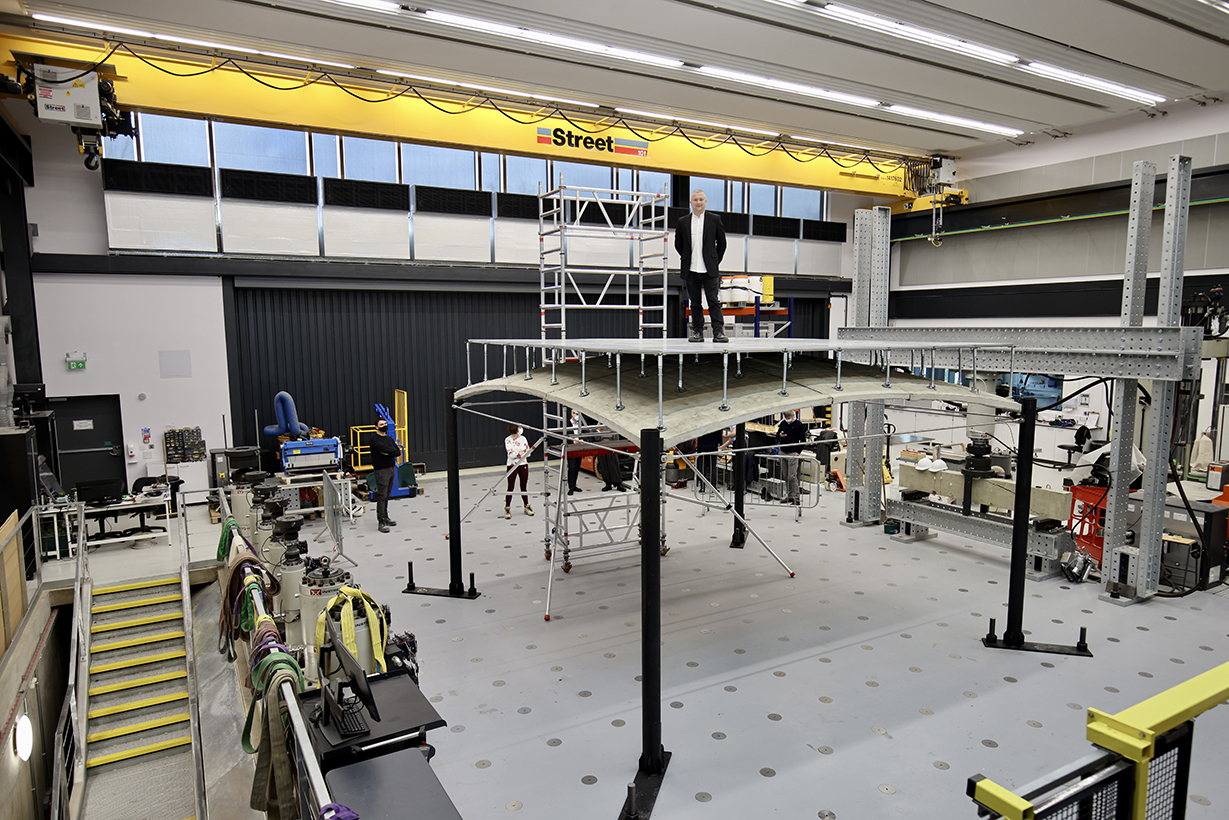Can construction in concrete benefit from copying the way stonemasons have worked for millennia? Dr Paul Shepherd at the University of Bath thinks so.
He says swapping solid slab concrete floors for a ‘thin shell’ vaulted alternative could help the construction industry towards its net-zero targets by cutting concrete use by 75%.
Of course, if stone were used rather than concrete the carbon content could be reduced to practically zero.
Dr Shepherd’s new vaulted style of floor was developed by an interdisciplinary team of structural engineers, mathematicians and manufacturing experts from the Universities of Bath, Cambridge and Dundee.
They have now unveiled a full-scale demonstration of a thin-shell floor, which cuts the carbon footprint by 60% compared with an equivalent flat slab floor that could carry the same load.
The curved vault-shaped structure is covered by standard raised floor panels to create a level surface.
Created by the UK Research & Innovation*-funded ACORN (Automating Concrete Construction) research project, the vault-shaped floor design takes advantage of concrete’s strength under compression, just as vaulted stone (or brick, come to that) ceilings do.
Dr Shepherd, a Reader in Bath’s Department of Architecture & Civil Engineering and the Principal Investigator for ACORN, says: “Achieving the net-zero targets recently ratified at the COP26 conference will require significant change by the construction industry, which is responsible for about half of the UK’s total emissions.
“Since concrete is the world’s most widely consumed material after water, and its production contributes more than 7% of global CO2 emissions, the easiest way for construction to begin its journey to net-zero is to use less concrete.
“That has been the driving force behind this project, which we hope could make a major difference to the impact of construction.”
Innovations in robotics, automated design and off-site fabrication are key. Currently most building floors use thick flat slabs of solid concrete, which rely on the bending strength of concrete to support loads. But concrete is not good at resisting the tension induced by bending, so these floors also need a lot of steel reinforcement.
The solution, as stonemasons have known for thousands of years, is to replace the tension with compression by vaulting.
The shape might prove impractical to make on modern, fast-track construction sites using traditional temporary formwork, so the ACORN team has also developed an automated adaptable mould and a robotic concrete spraying system that can be used off-site in a factory using purpose-written software to optimise the floor design for any given building.
Since the floor is made off-site, it needs to be transported to site and then assembled. This means splitting a large floor into transportable pieces. That required a system to connect them on site, which the team has also developed, bringing further advantages in reducing the time needed on-site for assembling the sections.
The ACORN team has learnt another trick from stone – re-using material at the end of a building’s life. The joints have been designed so that the floor can be dismantled and re-used elsewhere, helping towards a circular economy for the construction industry.
The practicality of this integrated system has just been demonstrated to ACORN’s industry partners in a full-scale 4.5m x 4.5m thin-shell structure in the NRFIS Laboratory of Cambridge University’s Civil Engineering Department.
Despite being the first of its kind, each piece of the floor erected at Cambridge took only half an hour to make, and the whole floor took just a week to assemble. Future commercial versions could be manufactured in dedicated industrial facilities even more quickly and site erection times could be reduced as familiarity with the system grew.
Dr Shepherd says: “After three years of research it’s amazing to see the fruits of all our hard work dominating the laboratory and drawing interested looks from all who pass by. It’s not every day you can jump on top of your research! I just hope that one day soon this type of low-carbon, automatically manufactured building becomes so widespread that people walk by without noticing.”
Adam Locke, Programme Leader of Europe Hub Technology & Innovation at Laing O'Rourke, one of the ACORN partners, adds: “The ACORN Demonstrator is a very useful stepping-stone in the progressive pathway to decarbonizing our solutions, and complements very well our own work in this area.”

